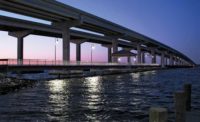Louisville-Southern Indiana Ohio River Bridges Project, East End Crossing
Louisville, Ky., and Jeffersonville, Ind.
Best Project
Owner: Indiana Finance Authority
Owner’s Representative/Technical Advisor: Parsons Corp.
Lead Design Firm/Structural/Civil Engineer: Jacobs Engineering Group
General Contractor: WVC Construction
Consultant: International Bridge Technologies Inc.
Consultant: Lachel & Associates
The East End Crossing, now known as the Lewis and Clark Bridge, is roughly half of the $2.3-billion Louisville-Southern Indiana Ohio River Bridges Project, a multi-bridge modernization involving several crossings of the Ohio River between Louisville, Ky., and Jeffersonville, Ind. The bridges will make Louisville’s highway network more efficient by linking roads that previously terminated near the river in both states.
Two 300-ft-tall diamond-frame towers support a four-lane roadway with 104 cable stays. Contractors completed the 2,500-ft-long bridge through a P3 design-build process that included the Indiana Dept. of Transportation, Parsons, and WVB East End Partners, itself a consortium of Walsh Investors LLC, VINCI Concessions and Bilfinger Project Investments.
Designing and building the bridge involved an international team constructing an eight-mile-long expressway that included a 1,700-ft-long twin-bore tunnel on the Kentucky approach. The design-build method shaved more than seven years off a 15-year traditional design-bid-build construction schedule and saved more than $200 million in project costs.
Crews assembled the superstructure for the entire backspan portion of the Indiana bridge—measuring 540 ft long by 140 ft wide—in segments on grade in Indiana then launched them over temporary piers to the tower on that side of the river. High water delayed completion of the main span towers, affecting the project’s schedule. The backspan launching allowed the assembly of the superstructure steel to begin before the towers were completed and made it possible to regain lost schedule.
A major rockfall event happened halfway through construction of the tunnel on the Kentucky side. The tunnel’s schedule paralleled that of the main bridge, so the project team quickly had to determine why it happened and how to fix it.
The project team used an industry-tested system of steel rib sets and wood lagging to supplement the temporary support system and repair the collapsed tunnel section. With schedule-related penalties looming and project costs mounting, the team agreed that the steel sets and lagging would work long term and could be implemented quickly. Construction recovered from five months of delay with only 18 months remaining, and the project opened on time.
Related Article: A Great Year for Midwestern Innovation






Post a comment to this article
Report Abusive Comment